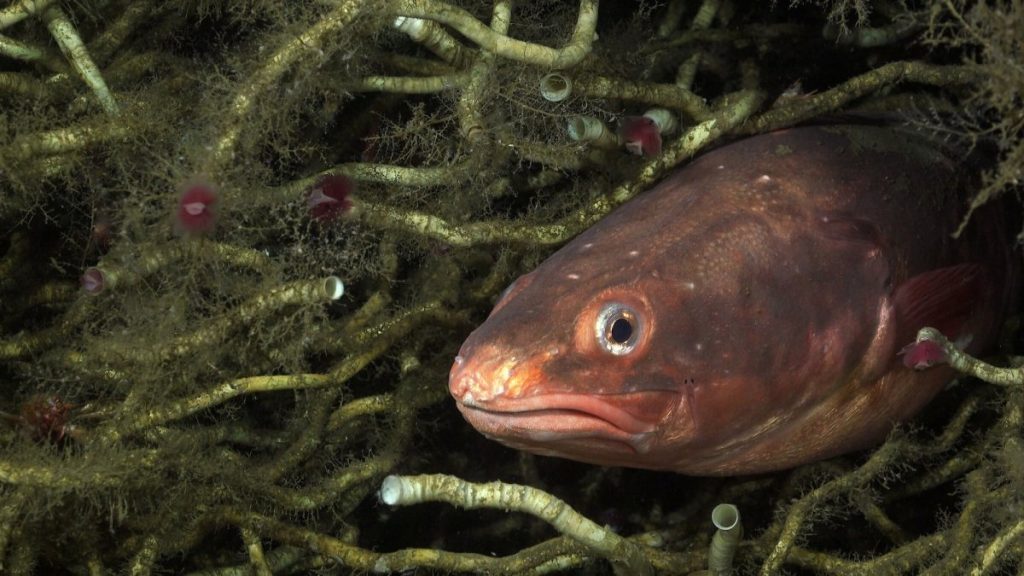For the first time, a Chilean seafood staple has been documented engaged in an unexpected relationship. According to a study recently published in the journal Ecology, cusk-eels (family Ophidiidae) are congregating deep underwater among tubeworm thickets near a methane seep in the Atlantic Ocean. The fish appear to favor the locale not for the sights, but for their neighbors—tiny spider crabs that feast on the animal’s parasites.
The cusk-eel is beloved in Chilean cuisine, so much so that the renowned poet Pablo Neruda penned an ode to the “rosy” creature of “snowy flesh.” However, they aren’t actual eels (Anguilliformes) in the true sense. Instead, they feature ventral fins from a forked organ underneath their mouths similar to carp. The average cusk-eel is around three feet long, but particularly prized species known as the red-cusk eel (Genypterus chilensis) can grow up to a length of five feet. Also known as the congrio colorado, red-cusk eels also live near the ocean floor off the coast of northern Peru and southern Chile.
Unfortunately, their commercial demand continues to strain overall population numbers. While the situation is still underresearched, a 2003 study determined that 75-percent of all caught cusk-eels had yet to reach sexual maturity. As recently as 2022, eel harvesters annually amassed around 2,000 tons of red cusk-eel. A better understanding of its life-cycle, habitat, and consequences from fishing could help conservation efforts.
A recent opportunity arose last year. Researchers aboard Schmidt Ocean Institute’s Research Vessel Falkor (too) unexpectedly documented the species engaged in never-before-seen behavior during an expedition. While using shipboard sonar to map deep ocean methane seeps about 11 miles off the coast of central Chile, the team noticed a particularly large tubeworm formation roughly 1,427 feet below the water’s surface. Tubeworms themselves are reliant on their own symbiotic relationship with the bacteria living among methane emissions along the ocean floor. The scientists decided to send down a remotely operated vehicle (ROV) named SuBastian to get a visual confirmation of the scene. Once there, they found more than tubeworms.
“At first we were amazed by the size of the tubeworm bush,” study co-author and University of San Diego oceanographer Lisa Levin said in a statement. “Eventually we noticed all these fish with their heads poking out from inside the bush.”
During the two ROV excursions to the site, Levin and colleagues tallied 46 to 48 red cusk-eels settled in their hiding spots. Video footage also showed spider crabs near the fish engaged in what appeared to be parasite cleaning. The study’s authors theorize that in addition to the parasite removal, the cusk-eels may also visit the tubeworm mound to feed, find shelter, or reproduce. Regardless, it illustrates a previously unknown, complex ecosystem involving the in-demand fish.
“The presence of this important fishery resource on a methane seep ecosystem close to the coast where it faces pressure from fishing and pollution forces us to think about measures to protect and conserve these habitats,” explained study co-author and expedition chief scientist Eulogio Soto.
Levin, Soto, and the others also noted a peculiar detail—this appeared the only mound that appealed to the red cusk-eels. Eleven other nearby tubeworm colonies collectively only housed three additional fish. Extensive human pollution in the form of nets and fishing gear on the surrounding ocean floor suggests the area may be a harvesting hotspot.
“Almost every time we visit these ecosystems, we find something new,” said Levin. “There is so much more for us to learn, and we need to keep exploring and studying them.”
Given the comparatively short time spent examining the formation, Levin and the others hope to return soon to learn more.
“Our discovery took place over the course of just two days, so we don’t know what life exists or what is happening at other times of the year. We must go back,” said Soto.


